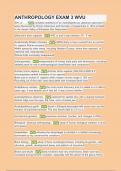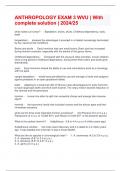Anthropology exam 3 wvu Study guides, Class notes & Summaries
Looking for the best study guides, study notes and summaries about Anthropology exam 3 wvu? On this page you'll find 42 study documents about Anthropology exam 3 wvu.
All 42 results
Sort by
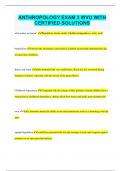
-
ANTHROPOLOGY EXAM 3 WVU WITH CERTIFIED SOLUTIONS
- Exam (elaborations) • 20 pages • 2024
- Available in package deal
-
- $9.99
- + learn more
ANTHROPOLOGY EXAM 3 WVU WITH CERTIFIED SOLUTIONS what makes us human? Bipedalism, brains, skulls, Childhood dependency, tools, teeth biopedalism stresses the advantages it provided in a habitat increasingly dominated by dry, savanna-like conditions. Brains and skulls Early hominins had very small brains, Brain size has increased during hominin evolution, especially with the advent of the genus Homo. Childhood dependency Compared with the young of other primates, human children h...

-
Anthropology Exam 3 WVU Questions And Answers With Real Tests
- Exam (elaborations) • 11 pages • 2024
-
- $11.99
- + learn more
Anthropology Exam 3 WVU Questions And Answers With Real Tests what are the three most important hominin evolutions? the Pliocene (5 to 2 m.y.a.), Pleistocene (2 m.y.a. to 10,000 B.P.) and Recent (10,000 B.P. to the present) epochs What are the six species in chronological order? 1. A. anamnesis (4.2 to 3.9 m.y.a.). 2. A. afarensis (3.8? to 3.0 m.y.a.). 3. A. africanus (3.0? to 2.0? m.y.a.). 4. A. garhi (2.5 m.y.a.) 5. A. robustus (2.0? to 1.0? m.y.a.). 6. A. boisei (2.6? to 1.0 m.y.a.). ...

-
Anthropology Exam 3 WVU Questions And Answers With Real Tests
- Exam (elaborations) • 9 pages • 2024
-
- $11.49
- + learn more
Anthropology Exam 3 WVU Questions And Answers With Real Tests what are the three most important hominin evolutions? the Pliocene (5 to 2 m.y.a.), Pleistocene (2 m.y.a. to 10,000 B.P.) and Recent (10,000 B.P. to the present) epochs What are the six species in chronological order? 1. A. anamnesis (4.2 to 3.9 m.y.a.). 2. A. afarensis (3.8? to 3.0 m.y.a.). 3. A. africanus (3.0? to 2.0? m.y.a.). 4. A. garhi (2.5 m.y.a.) 5. A. robustus (2.0? to 1.0? m.y.a.). 6. A. boisei (2.6? to 1.0 m.y.a.). ...

-
ANTHROPOLOGY EXAM 3 WVU Correctly Answered Questions| UpToDate | Already Graded A+
- Exam (elaborations) • 21 pages • 2024
- Available in package deal
-
- $12.49
- + learn more
what makes us human? : Bipedalism, brains, skulls, Childhood dependency, tools, teeth biopedalism : stresses the advantages it provided in a habitat increasingly dominated by dry, savanna-like conditions. Brains and skulls : Early hominins had very small brains, Brain size has increased during hominin evolution, especially with the advent of the genus Homo. Childhood dependency : Compared with the young of other primates, human children have a long period of childhood dependency, du...
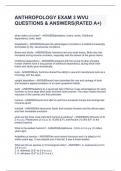
-
ANTHROPOLOGY EXAM 3 WVU QUESTIONS & ANSWERS(RATED A+)
- Exam (elaborations) • 9 pages • 2024
-
Available in package deal
-
- $11.99
- + learn more
what makes us human? - ANSWERBipedalism, brains, skulls, Childhood dependency, tools, teeth biopedalism - ANSWERstresses the advantages it provided in a habitat increasingly dominated by dry, savanna-like conditions. Brains and skulls - ANSWEREarly hominins had very small brains, Brain size has increased during hominin evolution, especially with the advent of the genus Homo. Childhood dependency - ANSWERCompared with the young of other primates, human children have a long period of chil...

-
ANTHROPOLOGY EXAM 3 WVU QUESTIONS WITH VERIFIED SOLUTIONS.
- Exam (elaborations) • 9 pages • 2024
-
- $11.49
- + learn more
ANTHROPOLOGY EXAM 3 WVU QUESTIONS WITH VERIFIED SOLUTIONS. What makes us human? - answerBipedalism, brains, skulls, Childhood dependency, tools, teeth biopedalism - answerstresses the advantages it provided in a habitat increasingly dominated by dry, savanna-like conditions. Brains and skulls - answerEarly hominins had very small brains, Brain size has increased during hominin evolution, especially with the advent of the genus Homo. Childhood dependency - answerCompared with the young o...
ANTHROPOLOGY EXAM 3 WVU Questions and Answers with complete actual solution
ANTHROPOLOGY EXAM 3 WVU | With complete solution | 2024/25
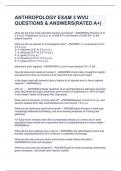
-
ANTHROPOLOGY EXAM 3 WVU QUESTIONS & ANSWERS(RATED A+)
- Exam (elaborations) • 7 pages • 2024
-
Available in package deal
-
- $11.99
- + learn more
what are the three most important hominin evolutions? - ANSWERthe Pliocene (5 to 2 m.y.a.), Pleistocene (2 m.y.a. to 10,000 B.P.) and Recent (10,000 B.P. to the present) epochs What are the six species in chronological order? - ANSWER1. A. anamensis (4.2 to 3.9 m.y.a.). 2. A. afarensis (3.8? to 3.0 m.y.a.). 3. A. africanus (3.0? to 2.0? m.y.a.). 4. A. garhi (2.5 m.y.a.) 5. A. robustus (2.0? to 1.0? m.y.a.). 6. A. boisei (2.6? to 1.0 m.y.a.). afarensis's brain capacity - ANSWER450 cc ...
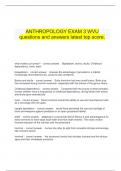
-
ANTHROPOLOGY EXAM 3 WVU questions and answers latest top score.
- Exam (elaborations) • 10 pages • 2024
-
- $12.99
- + learn more
ANTHROPOLOGY EXAM 3 WVU questions and answers latest top score. what makes us human? - correct answer. Bipedalism, brains, skulls, Childhood dependency, tools, teeth biopedalism - correct answer. stresses the advantages it provided in a habitat increasingly dominated by dry, savanna-like conditions. Brains and skulls - correct answer. Early hominins had very small brains, Brain size has increased during hominin evolution, especially with the advent of the genus Ho...

$6.50 for your textbook summary multiplied by 100 fellow students... Do the math: that's a lot of money! Don't be a thief of your own wallet and start uploading yours now. Discover all about earning on Stuvia



